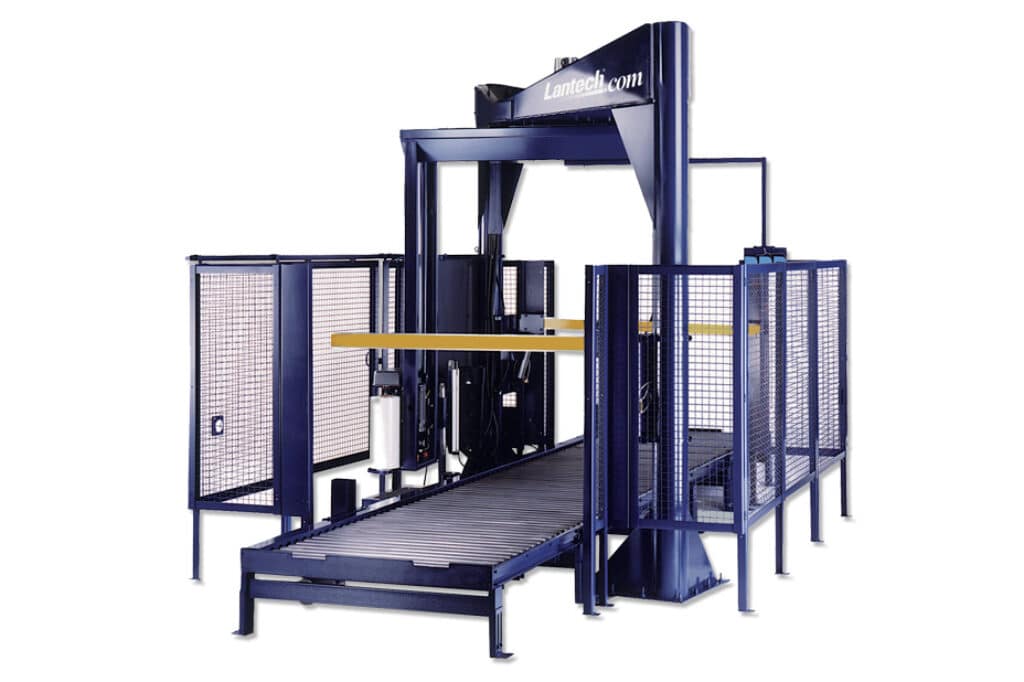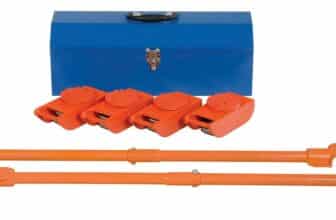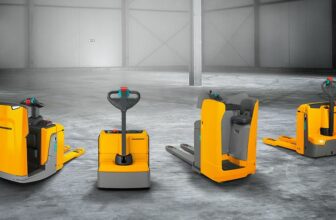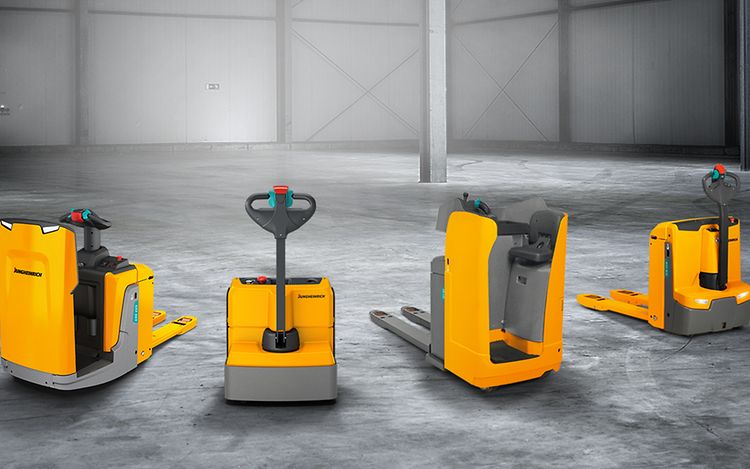
Pallet stretch wrap machines have revolutionized the packaging industry by streamlining the process of securing and protecting palletized loads. These automated devices have become essential for businesses that deal with large-scale shipping and warehousing operations. In this comprehensive guide, we will explore the world of pallet stretch wrap machines, their benefits, types, features, and how to choose the right one for your specific needs.
Understanding Pallet Stretch Wrap Machines
What is a Pallet Stretch Wrap Machine?
A pallet stretch wrap machine, also known as a pallet wrapping machine or a pallet shrink wrap machine, is a piece of automated equipment specifically designed to secure palletized loads by applying stretch film around them. It eliminates the need for manual labor and ensures consistent and efficient wrapping.
How Does a Pallet Stretch Wrap Machine Work?
A pallet stretch wrap machine works by holding the pallet in place while a film carriage rotates around it, dispensing stretch film. The film is stretched and wrapped around the load, creating a tight and secure wrap. The machine may offer different wrapping modes and patterns to suit various load requirements.
Advantages of Using a Pallet Stretch Wrapper
Pallet stretch wrap machines offer several advantages that can significantly improve efficiency, productivity, and safety in the packaging and transportation process. Here are the key advantages of using a pallet stretch wrap machine:
- Increased Efficiency: One of the primary benefits of using a pallet stretch wrap machine is the significant increase in efficiency compared to manual wrapping methods. These machines automate the wrapping process, eliminating the need for manual labor and reducing the time required to wrap each pallet. With automated machines, operators can wrap pallets quickly and move on to other tasks, resulting in higher productivity and throughput.
- Load Stability: Proper load stability is crucial during transportation to prevent damage to the products being shipped. Pallet stretch wrap machines ensure that the pallet loads are securely wrapped, providing stability and reducing the risk of load shifting or toppling during handling or transportation. The machine applies consistent tension to the stretch film, tightly securing the products to the pallet, and minimizing the potential for damage during transit.
- Cost Savings: Pallet stretch wrap machines can help reduce packaging material costs and minimize waste. These machines are designed to optimize the usage of stretch film, applying the right amount of film to achieve the desired load stability while minimizing excess material. By using less film, companies can save money on packaging materials in the long run. Additionally, the consistency provided by the machine ensures that there is minimal film wastage due to improper wrapping techniques or human error.
- Consistency and Quality: Manual wrapping methods are prone to variations in tension, wrapping patterns, and overall consistency. In contrast, pallet stretch wrap machines provide consistent tension throughout the wrapping process, resulting in uniform and reliable wraps. The machines are programmed to apply the appropriate tension and wrapping patterns, ensuring that each pallet is wrapped with the same level of quality and load stability. This consistency improves the overall appearance of the wrapped pallets and enhances the professional image of the company.
- Operator Safety: Wrapping pallets manually can be physically demanding and potentially hazardous for operators. It requires repetitive motions, bending, and reaching, which can lead to strain, fatigue, and injuries. Pallet stretch wrap machines eliminate the need for manual labor in the wrapping process, reducing the risk of operator strain or injury. Operators can simply load the pallet onto the machine, initiate the wrapping process, and attend to other tasks while the machine completes the wrapping operation. This significantly improves workplace safety and reduces the likelihood of workers’ compensation claims.
Pallet stretch wrap machines offer several advantages, including increased efficiency, improved load stability, cost savings, consistency in wrapping quality, and enhanced operator safety. These machines are valuable investments for companies looking to optimize their packaging processes, reduce costs, and ensure the safe transportation of their products.
Types of Stretch Wrapper Machines
Automatic Pallet Wrap Machines

Automatic pallet wrap machines, are innovative and fully automated systems designed to streamline the pallet wrapping process. These machines are equipped with advanced sensors, controls, and conveyors that enable them to handle the entire wrapping operation with minimal operator intervention. By leveraging cutting-edge technology, these machines are particularly suitable for high-volume operations that have consistent load sizes and require efficient throughput.
The automated nature of pallet wrap machines eliminates the need for manual labor, significantly reducing human involvement in the wrapping process. The machines are programmed to perform various tasks, such as loading the pallet onto the wrapping platform, applying the stretch film, adjusting tension levels, and cutting the film when the wrapping is complete. This automation enhances efficiency and productivity by reducing the time and effort required to wrap each pallet.
One of the key components of automatic pallet wrap machines is their advanced sensor systems. These sensors are designed to detect the dimensions, height, and weight of the pallet load, ensuring accurate wrapping and tensioning. By gathering precise data, the sensors enable the machine to apply the appropriate amount of stretch film and adjust the tension levels accordingly. This ensures optimal load stability while minimizing film waste.
The control systems integrated into these machines provide precise control over the wrapping process. Operators can set specific parameters such as wrapping patterns, film tension, and number of revolutions, allowing for customization based on the specific requirements of each load. The machines maintain consistent tension throughout the wrapping process, resulting in uniform and reliable wraps. This level of control ensures that each pallet is wrapped with the highest quality standards, improving the overall appearance and integrity of the wrapped load.
To facilitate the seamless operation of the pallet wrap process, automatic machines are often equipped with conveyors or roller systems. These systems enable the smooth movement of pallets onto the wrapping platform and assist in the wrapping and unloading processes. By incorporating conveyors, the machines can maintain a steady flow of pallets, further enhancing efficiency and throughput in high-volume operations.
Automatic pallet wrap machines are advanced and fully automated systems that require minimal operator intervention. They leverage advanced sensors, controls, and conveyors to handle the entire wrapping process efficiently. These machines are particularly beneficial for high-volume operations with consistent load sizes and throughput requirements. By reducing manual labor, improving precision, and increasing efficiency, automatic pallet wrap machines offer significant advantages in streamlining and optimizing the pallet wrapping process.
Semi-Automatic Pallet Wrap Machines

Semi-automatic pallet wrap machines offer a balance between manual and automated wrapping methods, providing some manual involvement while automating the majority of the wrapping process. These machines generally require the operator to attach the film to the load and initiate the wrapping process. Once the operator starts the machine, it takes over and automatically applies the film.
Semi-automatic pallet wrap machines are particularly suitable for businesses that have varying load sizes or lower production volumes. Unlike fully automated machines, which are designed for high-volume, consistent operations, semi-automatic machines offer flexibility in adapting to different load sizes and production demands.
By requiring the operator to attach the film and start the wrapping process, semi-automatic machines allow for some manual control and adjustment. This can be advantageous when dealing with irregularly shaped loads or fragile items that require careful handling. The operator can ensure the film is properly positioned and make any necessary adjustments before initiating the automated wrapping process.
While semi-automatic machines require some manual involvement, they still offer significant advantages over manual wrapping methods. The automated part of the process saves time and labor compared to entirely manual methods. The machine applies the film automatically, ensuring consistent tension and wrapping patterns, resulting in reliable and uniform wraps.
Moreover, semi-automatic machines provide a level of consistency and quality that is challenging to achieve with manual wrapping. They eliminate the variability that can occur with manual techniques, such as variations in tension or wrapping patterns due to operator fatigue or errors. This consistency enhances the overall appearance of the wrapped pallets and ensures load stability during transportation.
Semi-automatic pallet wrap machines strike a balance between manual and automated wrapping methods. They require some manual involvement, such as attaching the film and initiating the wrapping process, but automate the majority of the wrapping operation. These machines are particularly suitable for businesses with varying load sizes or lower production volumes, providing flexibility, efficiency, and improved wrapping consistency compared to fully manual methods.
Key Features to Consider
When choosing a stretch wrapper, several key features should be taken into consideration to ensure it meets your specific packaging requirements. Here are the essential features to consider:
Wrapping Modes and Patterns
Pallet stretch wrap machines offer different wrapping modes and patterns to accommodate various load configurations. Common wrapping modes include full wrap, top-sheeting, and banding. Patterns can range from simple spiral wraps to more complex roping or cross-pattern wraps. Assess your load characteristics and determine the appropriate wrapping modes and patterns needed for your products.
Film Tension Control
Film tension control allows you to adjust the tightness of the film during the wrapping process. This feature is crucial for achieving optimal load stability while avoiding overstretching or insufficient tension. Look for machines that offer adjustable tension settings to ensure the right amount of film is applied to each load.
Pre-Stretch Capability
Pre-stretching is the process of elongating the stretch film before it is applied to the load. This feature allows for better film utilization and cost savings, as it increases the film’s coverage area. Consider machines with pre-stretch capabilities, such as mechanical or powered pre-stretch systems, which provide higher stretch ratios and minimize film consumption.
Film Carriage System
The film carriage system holds and dispenses the stretch film during wrapping. It should be durable, reliable, and capable of accommodating various film roll sizes. Look for machines with easy-to-load film carriages and adjustable film tensioning mechanisms to ensure smooth and consistent film application.
Control Panel and Automation
A user-friendly control panel is essential for easy machine operation and adjustment of settings. Modern pallet stretch wrap machines often feature intuitive touchscreens or digital interfaces that allow operators to set wrapping parameters, select wrapping modes, and monitor the wrapping process. Automation features like programmable wrapping cycles and memory settings can further enhance efficiency and consistency.
Safety Features
Safety should always be a priority when selecting a pallet stretch wrap machine. Look for machines with safety features such as emergency stop buttons, safety barriers, and sensors that detect obstructions or irregularities during the wrapping process. Safety interlocks that prevent the machine from operating if doors or panels are open are also crucial for operator protection.
Choosing the Right Pallet Stretch Wrap Machine
To choose the right pallet stretch wrap machine for your specific needs, follow these guidelines:
Assessing Your Packaging Needs
Evaluate your packaging requirements, including load sizes, weight capacities, and the volume of pallets to be wrapped. Determine whether you need a high-speed machine for high-volume operations or a more versatile one for handling different load types.
Evaluating Load Characteristics
Consider the size, shape, and stability of your palletized loads. If you frequently handle irregularly shaped or unstable loads, opt for a machine that offers customization options and adjustable wrapping parameters to accommodate these variations.
Determining Throughput Requirements
Assess your desired wrapping speed and throughput capacity. If you have high production demands, choose a machine with fast wrapping cycles and high-speed capabilities. It’s essential to balance productivity requirements with the quality and stability of the wrapped loads.
Considering Available Space and Budget
Evaluate the available space in your facility and ensure the machine’s dimensions and operational requirements fit within your layout. Additionally, consider your budget constraints and determine the return on investment based on increased efficiency, reduced labor costs, and material savings.
Seeking Expert Advice
Consult with experts, such as packaging equipment suppliers or manufacturers, who can provide guidance and recommend suitable machines based on your specific requirements. They can help you navigate through the available options and select the most appropriate pallet stretch wrap machine for your business.
Frequently Asked Questions (FAQs)
What is the difference between an automatic and semi-automatic pallet wrap machine?
Automatic pallet wrap machines are fully automated and require minimal operator intervention. They often feature conveyors, advanced sensors, and controls that handle the entire wrapping process, from film attachment to cutting and securing the film. These machines are ideal for high-volume operations and provide consistent and efficient wrapping.
Semi-automatic pallet wrap machines, on the other hand, require some manual involvement. The operator typically attaches the film to the load and initiates the wrapping process. The machine takes over and automatically applies the film. While they still offer automation benefits, they are better suited for businesses with varying load sizes or lower production volumes.
The choice between automatic and semi-automatic machines depends on factors such as production volume, load variability, and desired level of automation.
Can a pallet stretch wrap machine handle irregularly shaped loads?
Yes, many pallet stretch wrap machines can handle irregularly shaped loads. Modern machines often feature customizable wrapping parameters, adjustable tension settings, and the ability to accommodate different load sizes and configurations. Some machines also offer special wrapping modes or patterns specifically designed for irregularly shaped loads, ensuring optimal load stability and protection during transportation.
When considering a pallet stretch wrap machine for irregular loads, it is important to consult with the equipment supplier or manufacturer to ensure the machine’s capabilities align with your specific load requirements.
Is it possible to integrate a pallet stretch wrap machine into an existing production line?
Yes, it is often possible to integrate a pallet stretch wrap machine into an existing production line. Many machines are designed with modular features, allowing for easy integration with conveyor systems or other equipment. Integration options may vary depending on the specific machine and the layout of your production line.
When considering integration, it is advisable to consult with experts or the equipment manufacturer to ensure compatibility and proper installation. They can provide guidance on the best integration methods to optimize workflow and maximize the benefits of automation.
How often should maintenance be performed on a pallet stretch wrap machine?
The frequency of maintenance for a pallet stretch wrap machine depends on various factors, including the machine model, usage intensity, and environmental conditions. It is recommended to follow the manufacturer’s guidelines for maintenance, which typically include regular inspections, cleaning, and lubrication.
In general, routine maintenance tasks should be performed at regular intervals, such as weekly, monthly, or quarterly, to ensure optimal performance and longevity of the machine. Additionally, any signs of wear, malfunction, or unusual noise should be addressed promptly to prevent further damage and maintain operational efficiency.
Can a pallet stretch wrap machine accommodate different types of stretch films?
Yes, pallet stretch wrap machines are designed to accommodate different types of stretch films. These machines typically have adjustable film tension controls and film carriage systems that can handle various film thicknesses, widths, and formulations.
Different stretch films may be required based on load characteristics, environmental conditions, or specific packaging requirements. Whether you need standard stretch films, pre-stretched films, or specialty films like anti-static or UV-resistant films, pallet stretch wrap machines can usually accommodate the appropriate film type.
However, it is essential to ensure that the machine you choose is compatible with the specific stretch films you intend to use. Consult with the equipment supplier or manufacturer to confirm compatibility and optimize performance.
Conclusion
Pallet stretch wrap machines offer efficiency, consistency, and cost savings when it comes to securing palletized loads for transportation and storage. By automating the wrapping process, businesses can optimize their operations and protect their products during transit. Remember to consider factors such as load characteristics, throughput requirements, available space, and budget when selecting a pallet stretch wrap machine. Always consult with experts to ensure you choose the right equipment for your specific needs.
We hope this comprehensive guide has provided you with valuable insights into the world of pallet stretch wrap machines. By understanding their functionality, types, key features, and selection criteria, you are now equipped to make an informed decision when choosing the right machine for your business.
Remember, assessing your packaging needs, evaluating load characteristics, determining throughput requirements, considering available space and budget, and seeking expert advice are essential steps in selecting the most suitable pallet stretch wrap machine.
Integrating an automated pallet wrap machine into your operations can significantly enhance productivity, improve load stability, and reduce costs associated with manual labor and packaging materials. By investing in the right machine, you can streamline your packaging processes and ensure the safe transportation and storage of your palletized loads.
For further assistance and guidance, don’t hesitate to reach out to packaging equipment suppliers or manufacturers who can provide you with expert advice tailored to your specific requirements. Stay up to date with advancements in stretch wrap technology and explore how these machines can further optimize your supply chain and packaging operations.
#PalletStretchWrapMachine #PackagingAutomation #ShippingandLogistics #WarehouseEfficiency #ProductProtection #PalletWrappingSolutions #IndustrialPackaging #SupplyChainManagement #PackagingMachinery #StretchWrapEquipment













